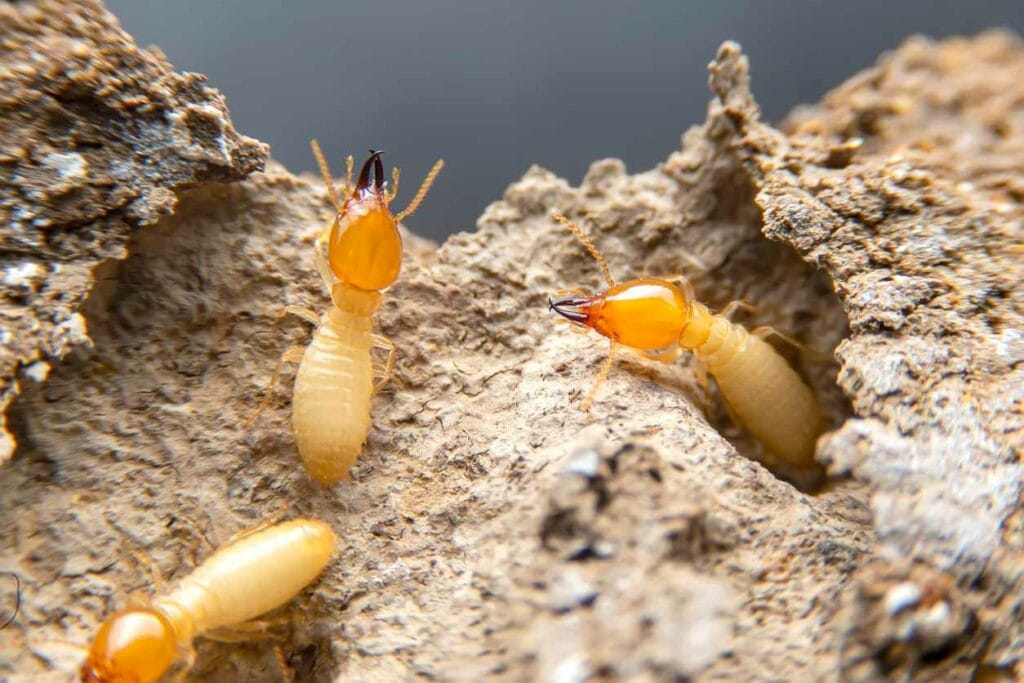Subterranean Termites in North Carolina
When we talk about termite damage in North Carolina, we’re often talking about subterranean termites. These termites build their colonies underground or in moist areas above ground. When it comes to infesting homes and buildings, subterranean termites often find their way to structures near the ground. Although these termites can become dehydrated and die if they are too far from the ground, they have the ability to create mud tubes that keep them safe, so they can venture far away from the ground if they develop tubes for accessing a food source.
What do subterranean termites look like?

Subterranean termites are generally cream colored. Although they range in size depending on their caste in the colony, most subterranean termites are between 0.125 and 0.375 inches in length. Some can reach up to an inch in length. Some termites, the “soldiers” who defend the colony, have brown heads and large mandibles.
What attracts subterranean termites?
Generally, warm conditions and moisture attract subterranean termites. That’s why North Carolina is a pretty great place for them. When it comes to food, subterranean termites love cellulose, which is found in a number of sources, including wood, paper, cardboard, and cotton. For our purposes, termite’s attraction to wood is a top concern. Even a small termite colony (standard ones can have up to around a million members) can cause serious damage to buildings and other wood-based structures.
Signs of a Subterranean Termite Infestation
Unfortunately, termites can often go undetected for a long time. Colonies often infest hard-to-see areas and can do lots of damage before they get discovered under normal circumstances. Unless you happen to see termites or piles of termite wings around your property, you may not be aware of an active infestation. While pest control professionals have additional tools at their disposal for termite colony discovery and prevention, some common and noticeable termite damage signs you might notice include:
- Mud tubes in or around your space
- Peeling or blistering wood surfaces
- Hollow-sounding wood
- Floorboards and other surfaces that buckle
Preventing a Subterranean Termite Infestation in Your North Carolina Home
Although the wooden structures of your home or building are generally attractive to termites, keeping vegetation low around lower foundation walls and siding can help expose these areas and make them less attractive to termites, who prefer shade and protection. You can also help keep conditions less appealing by staying on top of any moisture risks, like leaky plumbing and air conditioning condensation.
For a more intense prevention plan, you’ll need to talk with a team of pest control professionals. Pest control specialists can use different treatments to help prevent termites from infesting your home and/or stop a budding termite problem.
Treatment Options for Subterranean Termites
So what are your options for removing termites in North Carolina and halting the damage they may be causing to your space? Generally, subterranean termites can be treated with bait or liquid treatments. Liquid treatments will generally create a barrier that eliminates termites that make their way in, while bait systems are designed to be taken and spread amongst the colony by the termites themselves. Either option can help halt an active infestation. The team at Clegg’s can help you determine the best option for your property.
Prevent and Remove Subterranean Termites With Clegg’s Pest Control
Noticing signs of termite damage around your home or business or just interested in doing everything you can to prevent termite damage? Call in the team at Clegg’s! Our team can fully inspect your North Carolina property for termites and carry out any necessary treatments to help defend your home from destruction. Just contact us today for a free pest control estimate!
